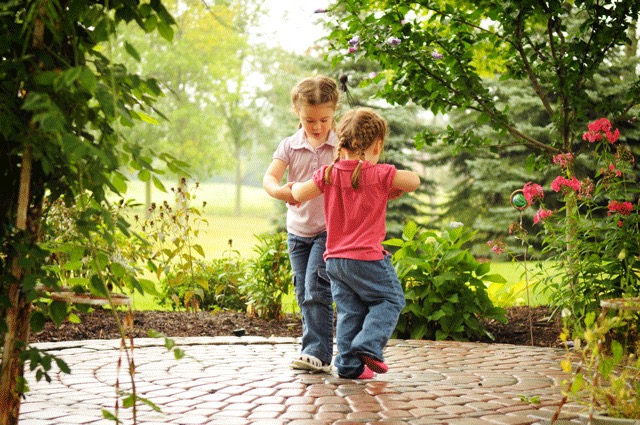It’s a beautiful day to be outdoors with the children. But are there any ways to help them meet fine arts benchmarks on the playground? Yes! Go ahead—investigate actions, space, and other elements of dance while outside. (See Illinois Early Learning and Development Benchmarks 19.B.ECa, 19.B.ECb, 19.B.ECc, 25.A.ECa, and 26.B.ECa.)

Help children practice the coordinated body movements that are a big part of dance.
- Show children the movements to folk dances, line dances, and round dances, so they can dance together. Try old favorites such as the Bunny Hop and the Hokey Pokey, too. Point out actions that involve following, leading, passing by, and connecting with each other. Then dance for the fun of it! (Note: Grassy areas can have hidden hazards, and it’s hard to move a wheelchair or walker on grass. Try using a paved area swept clean of anything that might cause injury to children.)
- Ask children to think about dancing on different surfaces. You might ask, “How do you think it would feel if you danced in the sand box?” Then let them test their predictions. Invite them to compare experiences. “How was marching in sand different from marching on the sidewalk? On the lawn? In the wading pool?”
- Help children organize a dance- or step-team routine. Take notes to help them remember their plan: “Min-Yung says to march for 8 steps. Kayla says to jump 4 times and then wave your ribbons.”
Invite children to experiment with space.
- Use cords to mark circles on the ground large enough to hold several children at once. Ask the children to dance inside their circles without touching anyone. Repeat the activity several times, making the circles smaller each time. Invite the children to talk about what they did to manage their movements in the smaller spaces. Then enlarge the circles so they can finish with large movements.
- Using cords, chalk lines, or footprints in snow, mark long paths for children to follow. The paths do not need to be simple and straight. They can twist and turn and go under playground equipment. Ask children to follow the paths while clapping their hands in rhythm or while you play recorded music. Let them try moving backward, too.
- Let children create new paths, choose music, and decide what actions to make. “Adam says swing your arms. Lola says take baby steps. Maybe you can try both at once!”
- Add props such as baskets, hats, or ribbons. Children can dance along a path, moving their props as the music inspires them. Children with walkers or wheelchairs can stay in place and use their props.
Note: Some children in the group may come from religious backgrounds in which dance is not allowed. Tactfully ask their parents to be specific about what is not permitted. For example, can the child play “Follow the Leader” if no music is playing?


 Printer-friendly PDF
Printer-friendly PDF PDF para imprimir
PDF para imprimir